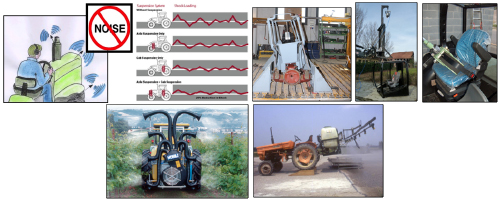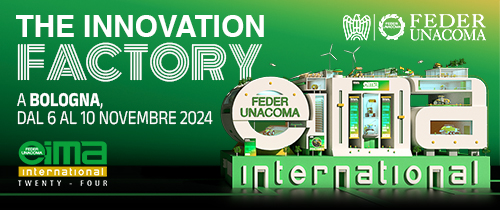Università degli Studi di Milano - Scienze Agrarie e Ambientali

Università degli Studi di Milano
Dipartimento di Scienze Agrarie e Ambientali
Via Celoria, 2 – 20133 Milano
www.unimi.it - www.disaa.unimi.it
Ref. AIIA Idraulica: Prof. Claudio Gandolfi, Tel. +39.02.503.16910 - claudio.gandolfi@unimi.it
(Idraulica Agraria – Agricultural Hydraulics and Hydrology)
Ref. AIIA Meccanica: Prof. Domenico Pessina, Tel. + 39.02.503.16876 - domenico.pessina@unimi.it
(Meccanica agraria – Agricultural Mechanics)
Ref. AIIA Costruzioni: Prof. Alessandro Toccolini, Tel. +39.02.503.16854 - alessandro.toccolini@unimi.it
Prof. Giorgio Provolo, Tel. +39.02.503.16855 - giorgio.provolo@unimi.it
(Costruzioni Rurali – Rural Buildings and Landscape Planning and Design)
Research activities - Laboratories and scientific equipment
Research on safety, ergonomics and operator’s wellness: research and tests on Roll Over Protective Structures (ROPS) and Falling Object Protective Structures (FOPS). The Agricultural Mechanics area of DiSAA is an Accredited Centre for the execution of ROPS, FOPS and safety belts attachments tests.
Research on sprayers: the Agricultural Mechanics area of DiSAA acts as Scientific Consultant for the execution of tests for the periodical check and set-up of sprayers in use.
Sensors and automation for biosystems
Development of new sensors and application of automatic control in crop systems and bioprocesses; robotics for highly-selective crop protection treatments; fluorescence measurements for very early stress detection in plants; volatile fatty acids sensing in anaerobic digestion; fuzzy control in biohydrogen production by fermentation process; automatic field units for monitoring pest-insects activity.
Non-destructive technologies and FEM modelling in agro-food systems
Characterization of fruit and vegetables through non-destructive systems in pre- and post-harvest for quality assessment: Vis / NIR (Visible/Near Infrared) technologies for the field and the post-harvest centers. Devices for the detection of traditional quality parameters (hardness, sugar content, acidity) and nutraceuticals (chlorophyll, flavonoids, polyphenols , ascorbic acid and carotenoids). Fresh fruits and vegetables: cold chain optimization, storage rooms fluid dynamic characterization, passive refrigerator systems Baking: heat and mass transfer, volume changing development, crust formation optimization Enological sector: optimization of tartrate formation during stabilization, vapor barrique sterilization Chocolate industries: mold shape optimization.
Bioenergy engineering and management
Management and technical solutions for biomass energy production and supply chain: Extensive monitoring of operative parameters of the supply chain under conditions; technical-economical modelling tools for defining optimal management ; two-stage process for bio-hydrogen and biogas production (one of the first field prototype at UNIMI experimental farm) ; Life Cycle Assessment - LCA of biomass energy production chain.
Sustainability of agro-industrial process
Management and technical solutions for biomass energy production and supply chain: energy assessment in the process of pasta, beer and cheese production, medicinal spice and chestnuts drying: evaluation of energy process index, suggestions of technical solutions, technological optimization; Life Cycle Assessment (LCA): evaluation of the wine production and of the fresh cut fruit and vegetable process; Definition of new sustainable indices with particular regard to emerging processes.
Machinery monitoring and traceability in spreading operation
Automatic systems for traceability of animal slurry or chemical application in fields: RFID technologies for automatic recognition of applied pesticides; Development of VRT for slurry spreaders; GPS-based traceability information system of N application rate ; Farm field-logs with automated recognition of plot/operation.
Modelling tools for farm machinery evaluations
Appropriate mechanization in agricultural systems: Optimization of farm machinery management; modelling of repair and maintenance costs of agricultural machines ; Technical-economical analysis of mechanized processes.
Sustainable manure management
Test of solid-liquid separators of different technologies; use of additives for the reduction of emissions to air; monitoring of treatment plants for energy production and nitrogen removal; Assessment of emissions to air from storages in controlled field conditions; Aeration and ammonia stripping techniques for nitrogen removal.
Manure production and characteristics
Flocculation tests of slurries and digestates with natural and sinteric additives; manure production assessment in relation to live weight and feeding in intensive pig farms; physical, optical and electrical properties of animal manure; Monitoring production and characteristics of animal slurries.
Animal welfare for health and productivity
Automatic systems to monitor dairy cow behaviour, through videorecording and automatic movements detection using accelerometers, devoted to acquire information to ascertain if the cows are resting enough and if the automatic feeding system might affect cow behaviour.
Landscape resources assessment
Assessment of rural landscape resources and application to italian context; realization of landscape and environmental resources maps; landscape planning methods, definition of suitable areas for different types of development.
Geographical Information Systems
Creation of geographical databases for different territorial levels (municipality, province, park, region); landscape and environmental analysis using GIS and remote sensing data, realization of topographic and thematic maps; web GIS applications; land survey with GPS and Total station.
Green areas and Greenways planning and design
Design of green areas; healing gardens and school gardens; greenways planning and design (recovery of abandoned railways and reuse as greenways, greenway design technical elements).
Modelling water requirements
Intensive monitoring for a suitable in-situ characterization of water dynamics; extension of the results from plot to regional scale; district water demands estimation; irrigation amounts forecasting for scenarios studies (changes in crop types, irrigation methods, water table depth, etc.).
Root reinforcement modeling
Experimental measurements in the forests (root distribution analysis); laboratory tensile tests on roots; application of models for root reinforcement estimation; implementation of root reinforcement in slope stability models.
Effects of forestry on root reinforcement
Comparison between differently managed broadleaves stands (coppiced/ abandoned); monitoring and modeling the effects of gap cutting on coniferous forests; evaluation of the contribution of natural regeneration and shrub species.




